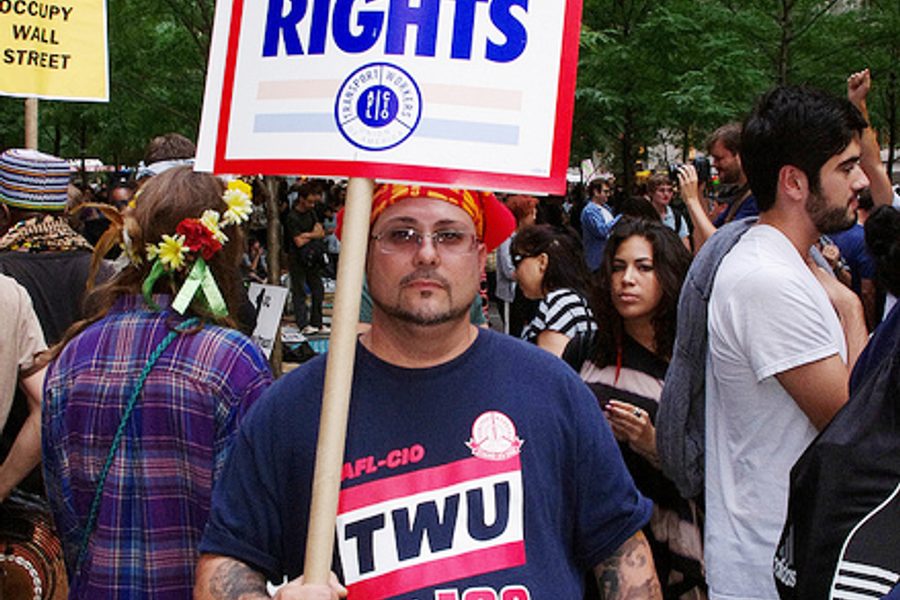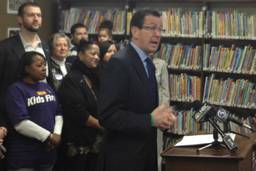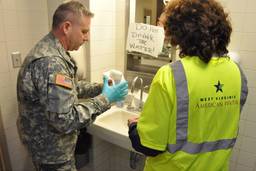
NEW YORK —The union movement didn’t lead the Occupy Wall Street movement that began on Sept. 17 – but it didn’t take long for many union members and local unions to begin happily supporting it. Earlier this month, the head of the “house of labor,” Richard Trumka, blessed it.
During the first action in Manhattan that had significant labor support – a rally in Foley Square and a march past Zuccotti Park to Wall Street on October 5 — there were no waves of colorful matching T-shirt clad workers making their presence very obvious. But there were smaller contingents of workers from many unions, and some individual members of unions scattered throughout the large, upbeat and noisy crowd.
One week later, on October 12, 500 purple-shirted members of SEIU Local 32BJ — which represents 60,000 commercial cleaners along the East Coast from D.C. to Boston — marched into Zuccotti Park in solidarity with OWS. On Tuesday, Local 32BJ spokesman Kwame Patterson said that the march had been planned in solidarity with local members in Philadelphia and Washington, D.C., whose contracts expired that week.
“Within the week leading up to Oct. 12, Occupy Wall Street gained momentum… as a grassroots movement. … Based on that, we actually worked together,” Patterson says. “We pledged support for their cause and they pledged support for us. We’re all under the same mesasge: [W]e believe wealth is not being shared and there is a huge economic wealth gap that needs to be addressed immediately, or there’s no longer going to be a middle class in America.”
As The Socialist Worker reported today, “the connections between organized labor and the OWS continue to deepen — with ongoing protests against the Sotheby’s auction house where Teamsters have been locked out of their jobs, a big rally in support of Verizon workers who are fighting for a fair contract and a planned action against the Department of Education in support of teachers.”
While union leaders representing teachers, nurses, transport workers, service workers and others addressed the gathered throngs in Manhattan on October 5, I wandered through the crowd interviewing some of those who could be identified as union members by their shirts or the signs and banners they carried.
Peter Foley was one of several members of New York’s Transit Workers Union holding their banner aloft. He said his union tried and failed to get an injunction preventing New York City cops from commandeering buses to haul arrested protesters to jail, as they had done the week before when 700 were arrested on the Brooklyn Bridge. The Occupy Wall Street movement is sometimes criticized for not articulating specific demands, but when I asked several people to name one specific demand, they immediately stated their priorities.
Foley said, “Me, I want to see a stock transaction tax and I want that to be used to rebuild America and put people back to work.”
Paul Armstrong, a union ironworker who’d come out from Los Angeles to take a job doing ornamental iron work, said his top demand was, “Corporate lobbyists out of Washington. I don’t care if they’re Republican or Democrat, it seems to me that all politicians are in somebody’s pocket and it’s not right that working class Americans have no say anymore.”
Mike Hellstrom is a member of Laborers Local 108, which represents workers in the private sanitation industry. He says the recession has taken a toll, with more than 300 members laid off out of 2,200. He said only a handful of his members had come out, but added, “As this movement grows, we’ll be putting the call out to our members to come out in a more robust fashion.” He also had a specific demand: “I think the financial community and the government has an obligation to ensure and encourage the use of defined benefit pension plans in this country.”
Juliana Francis Kelly was at the march with her daughter Margaret. She said she and her husband are both members of the Screen Actors Guild, and that in the past few years she’s been working harder and longer for less pay. “And so when Wall Street gets a bailout and then you read about the enormous bonuses their chief executive officers are receiving, it’s just not right, and I think this is a really powerful and wonderful way to communicate that – good old fashioned protest.”
Ramona Perez is an adjunct in the Urban Studied Department at Queens College, earning what she described as “terrible pay — $22,000 for three classes, which is considered full-time.” Her favored demand is “a fair living wage.”
David Martinez is a Teamster. He works at Sotheby’s auction house, which locked out workers almost three months ago, demanding major concessions. “They want to cut our retirement, our overtime, they want to cut our work week back and put stringent work rules in to make it really easy to fire people. Basically they’re trying to kill the union.”
Martinez’s demand: “Respect the people who do the work for you. Everybody down here are workers, and the one percent of the people make all the money off the rest of them.” He said some of the occupiers came out to support their picket line, and the Teamsters were coming down to Wall Street to show their solidarity.
Alison Omens, an AFL-CIO spokesperson, says that union members and unions are coming out in ever stronger numbers to support the Occupy actions around the country.
“Union families across the country are participating in these Occupy events as well as calling for jobs,” she said. “We’ve been saying that for a long time” — she referenced the AFL-CIO-backed “One Nation Working Together” rally held in October 2010 — “that things are not right and we’re not going to take it anymore. It’s fantastic that people are standing up and saying it, too.”
She said the first statement of support — before AFL-CIO President Trumka and the labor federation’s executtive council formal suppport — came on October 2 at an AFL-CIO-sponsored young worker summit in Minneapolis.
Omens said there’s been no national deployment of AFL-CIO resources, because the needs are different in different cities. Union support is coming in various ways – labor lawyers providing advice, locals opening their union halls, and people in each city determining what the movement needs, like sleeping bags, food or water. Pizza delivered to the Wall Street occupiers has been a popular item..
As Occupy Wall Street grows day by day, and Occupy actions proliferate around the country, union members will have lots more opportunities to support – and perhaps lead – these historic protests.
“We’ve been marching on City Hall and Wall Street and other areas for decades now. Anything that can shed light on the plight of working people, we think that’s great,” SEIU Local 32BJ spokesman Patterson says. “We’ve been doing these things for years,” he replied, “and the mainstream media became complacent. When new players step up to the plate it seems new. We’re happy that others are getting involved.”








